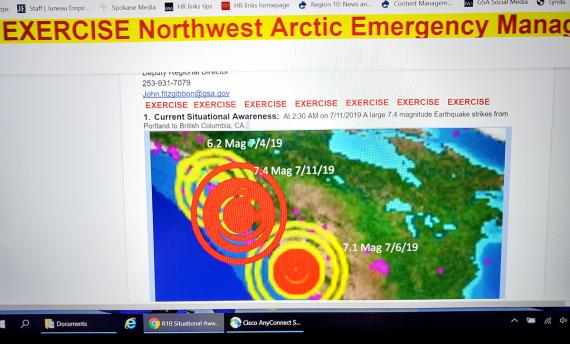R10 Trains in Case of an Earthquake as Real One Occurs

Early last Friday morning, deep beneath the surface of the western Washington state landscape in GSA’s Northwest Arctic Region, the Earth was shifting resulting in a magnitude 4.6 earthquake.
Later that morning, GSA Region 10 staff woke up to start their day, which included launching the first-ever virtual emergency management drill that included a simulated 7.6 magnitude earthquake striking along the Washington and Oregon coastline.
As Region 10 teams walked through their disaster planning scenario, using Google Hangouts to connect with one another, the ground was literally shaking with aftershocks from the REAL earthquake earlier.
The Cascadia Subduction zone gets most of the attention in the Northwest due to its potential to unleash the big one - an earthquake of 7.5 or greater - hence the need to ensure GSA’s Region 10 is ready and prepared for a natural disaster.
Countless hours are spent on preparing emergency plans and drilling on scenarios that most often times include an earthquake. The work includes plans to ensure buildings are seismically ready, escape plans for tenants in the event of a disaster, and measures to check buildings after an event to ensure safety.
However, this drill would be different for two reasons: one, the real earthquake that occurred just hours earlier; and two, the use of a virtual environment to connect participants in the drill.
The work during an emergency event is all coordinated out of the Northwest/Arctic Region regional office in Auburn, WA. But often, staff are scattered - away from work for vacations, telework, and on site at other federal locations. Bringing the region’s leadership back together during an emergency is crucial to having a successful recovery from a natural disaster. But that takes time and time is crucial in emergency situations.
That’s why leaders in Region 10 opted to test-drive a new way of connecting using linked Google Hangout “rooms” and shared online documents to note the progress of the emergency drill.
“It’s not unusual for us to be training for this and it’s not unusual for our area to have an earthquake,” said John Fitzgibbon, Deputy Regional Director Western Regions Division
Office of Mission Assurance. “It is unusual for all of it to happen the same day.”
It’s also a reminder of the need for GSA to make sure everyone is ready and accessible, and the team was using this new virtual approach to determine if the speed at which different teams could communicate improved.
“This training is vital to our being ready,” said Chaun Benjamin, Acting Regional Administrator for the Northwest/Arctic Region. “The virtual environment proved to be successful for us and we’re eager to continue fine-tuning it so it becomes a viable option for us down the road.”
Using Google Hangouts, GSA’s Region 10 staff gathered virtually to learn of the severity of the simulated earthquake. Then, each division completed a mission based on the needs for recovery from the event. This included simulations in everything from checking on structural integrity of buildings, clarifying misinformation in the media, to deciding what to do with displaced employees who could no longer get back into their building due to damage.
All of it done, remotely and online.
“It’s all part of the drill. We create these situations to test everyone’s ability to troubleshoot and solve it,” Fitzgibbon said. “And now we’re trying it in a virtual environment in real time.
In the end, the real quake’s aftershocks subsided and the earthquake emergency management exercise proved to be valuable for learning what to do if a larger one hits the Northwest. It also showcased some new technology, that down the road, may prove to be invaluable to connect staff in different locations during a real emergency.

 U.S. General Services Administration
U.S. General Services Administration